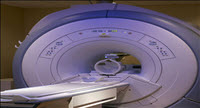
All is quiet at 10:30 pm until a nurse notices water on the 2nd floor hallway. Building maintenance is called and discovers a ruptured pipe fitting in a bathroom on the 2nd floor. The water is shut off at 10:45 pm but unfortunately the damage has been done. It is later discovered that water penetrated through perforations in the ceiling in the CT suite on the 1st floor exposing the 16-slice CT gantry and patient table to water.
The next morning, Clinical Engineering contacts the manufacturer, who holds the service contract on the scanner, and the manufacturer's service engineer arrives to inspect the equipment. The service engineer finds that water has penetrated inside the gantry and patient table. The manufacturer notifies the hospital that they will no longer service the CT under the current service contract and recommends replacement of the unit at a cost of approximately $500,000. The lead time on the replacement is 8 weeks, during which time the hospital cannot use the CT. Replacement will necessitate demolition and reconstruction of a lead-lined wall in order to remove the damaged unit and bring in the replacement.
As the risk manager of the facility, what do you do now? Do you approve replacement of the equipment? Or are there other options available that mitigate your monetary exposure, reduce the amount of time you cannot provide full patient care and further minimize the potential exodus of patients to other hospitals? Is replacement the best option for all stakeholders of the equipment (i.e. the hospital, the manufacturer and the insurer/captive)? How do you balance the interests of all stakeholders to bring about the elegant solution?
Envista Forensics can assist you with this process. Our degreed biomedical and electrical engineers and restoration specialists have been involved in hundreds of such situations. Not only do we understand all the various pieces of imaging, laboratory, surgical and patient monitoring equipment in your facility, we also understand the restoration and repair processes required to return equipment to safe and reliable operation, if possible. Our restoration specialists work with manufacturers, hospital staff (Clinical and Biomedical Engineering) and insurance representatives to develop and implement the appropriate cleaning and repair processes to address the concerns of all stakeholders in a timely and cost-effective manner.
Not only is repair and decontamination a timely and cost-effective option for the equipment itself, it also minimizes demolition and construction costs, business interruption losses and extra expense costs. Most importantly, it allows the hospital to provide patient care more quickly. For more information on the solutions Envista Forensics can provide on medical and laboratory equipment losses, contact Andrew Spetter, Director of Equipment Restoration, at (800) 326-5075, extension 7058.
Envista Forensics is a global leader in Forensic Engineering & Recovery Solutions. They provide Cause & Origin, Failure Analysis, Fire and Explosion Investigations, Accident Reconstruction, Damage Evaluations and Equipment Restoration Services following disasters of all kinds. Envista has offered Consulting Services to the insurance, legal and risk management industries as well as businesses, public entities, and universities for over 25 years. Their Experts travel globally from 30 offices located across the U.S., Canada, Mexico, the U.K., Australia, and Singapore.
©Copyright - All Rights Reserved
DO NOT REPRODUCE WITHOUT WRITTEN PERMISSION BY AUTHOR.












